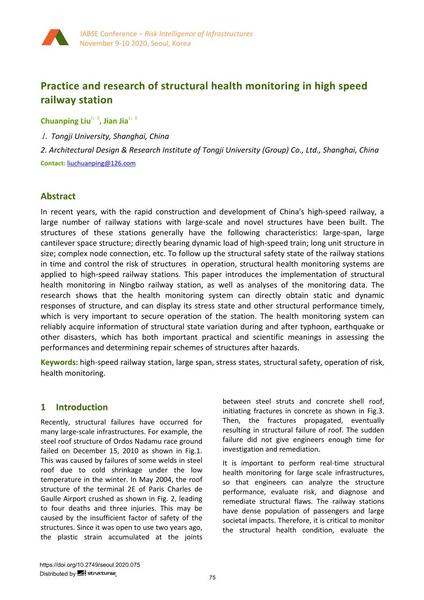Practice and research of structural health monitoring in high speed railway station

|
|
|||||||||||
Bibliographic Details
| Author(s): |
Chuanping Liu
(Tongji University, Shanghai, China; Architectural Design & Research Institute of Tongji University (Group) Co., Ltd., Shanghai, China)
Jian Jia (Tongji University, Shanghai, China; Architectural Design & Research Institute of Tongji University (Group) Co., Ltd., Shanghai, China) |
||||
|---|---|---|---|---|---|
| Medium: | conference paper | ||||
| Language(s): | English | ||||
| Conference: | IABSE Conference: Risk Intelligence of Infrastructures, Seoul, South Korea, 9-10 November 2020 | ||||
| Published in: | IABSE Conference Seoul 2020 | ||||
|
|||||
| Page(s): | 75-81 | ||||
| Total no. of pages: | 7 | ||||
| DOI: | 10.2749/seoul.2020.075 | ||||
| Abstract: |
In recent years, with the rapid construction and development of China's high-speed railway, a large number of railway stations with large-scale and novel structures have been built. The structures of these stations generally have the following characteristics: large-span, large cantilever space structure; directly bearing dynamic load of high-speed train; long unit structure in size; complex node connection, etc. To follow up the structural safety state of the railway stations in time and control the risk of structures in operation, structural health monitoring systems are applied to high-speed railway stations. This paper introduces the implementation of structural health monitoring in Ningbo railway station, as well as analyses of the monitoring data. The research shows that the health monitoring system can directly obtain static and dynamic responses of structure, and can display its stress state and other structural performance timely, which is very important to secure operation of the station. The health monitoring system can reliably acquire information of structural state variation during and after typhoon, earthquake or other disasters, which has both important practical and scientific meanings in assessing the performances and determining repair schemes of structures after hazards. |
||||
| Keywords: |
structural safety health monitoring high-speed railway station large span stress states operation of risk
|
||||
